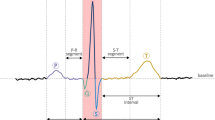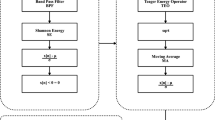Abstract
Abnormal intra-QRS potentials (AIQPs) in signal-averaged electrocardiograms have been proposed as a risk evaluation index for ventricular arrhythmias. The purpose of the paper was to develop an automatic algorithm for selecting the optimum parametric model order in the analysis of AIQPs to make the modelling approach clinically more feasible. A total of 130 normal Taiwanese subjects and 87 patients with ventricular premature contractions and 23 with sustained ventricular tachycardia were recruited. The unpredictable AIQP signal was estimated from the modelling residual. The cross-correlation coefficient between the original signal and the QRS estimate was employed to evaluate the accuracy of the estimate. A pre-selected threshold cross-correlation coefficient of 0.9999 was used to determine the optimum order. The mean AIQP in lead Y for ventricular tachycardia patients was 3.9 μV, which was significantly smaller than 4.9 μV for ventricular premature contraction patients (p<0.01) and 6.3 μV for normal subjects (p<0.001). The linear combination of AIQP in lead Y and the time-domain parameter RMS40 provided the best global performance (the area under the receiver operating characteristic curve was 89.1%). A higher risk of ventricular arrhythmias was associated with lower AIQP in lead Y, and the automatic modelling algorithm improved the clinical feasibility of AIQP analysis.
Similar content being viewed by others
References
Akaike, H. (1969): ‘Fitting autoregressive models for prediction’,Ann. Inst. Statist. Math.,21, pp. 243–247
Akaike, H. (1974): ‘A new look at the statistical model identification’,IEEE Trans. Autom. Control,19, pp. 716–723
Ahmed, N., Natarajan, T., andRao, K. R. (1974): ‘Discrete cosine transform’,IEEE Trans. Comput.,23 pp. 90–93
Bai, O., Nakamura, M., Nagamine, T., andShibasaki, H. (2001): ‘Parametric modelling of somatosensory evoked potentials using discrete cosine transform’,IEEE Trans. Biomed. Eng.,48, pp. 1347–1351
Breithardt, G., Cain, M. E., El-Sherif, N., Flowers, N., Hombach, V., Janse, M., Simson M. B., andSteinbeck, G. (1991): ‘Standards for analysis of ventricular late potentials using high-resolution or signal-averaged electrocardiography: a statement by a task force committee of the European Society of Cardiology, the American Heart Association, and the American College of Cardiology’,J. Am. Coll. Cardiol.,17, pp. 999–1006
Cain, M. E., Ambos, H. D., Witkowski, F. X., andSobel, B. E. (1984): ‘Fast-Fourier transform analysis of signal-averaged electrocardiograms for identification of patients prone to sustained ventricular tachycardia’,Circulation,69, pp. 711–720
Cain, M. E., andErson, J. L., Arnsdorf, M. F., Mason, J. W., Scheinman, M. M., andWaldo, A. L. (1996): ‘Signal-averaged electrocardiography’,J. Am. Coll. Cardiol.,27, pp. 238–249
Gomis, P., Jones, D. L., Caminal, P., Berbari, E. J., andLander, P. (1997): ‘Analysis of abnormal signals within the QRS complex of the high-resolution electrocardiogram’,IEEE Trans. Biomed. Eng.,44, pp. 681–693
Griner, P. F., Mayewski, R. J., Mushlin, A. I., andGreenland, P. (1981): ‘Selection and interpretation of diagnostic tests and procedures. Principles and applications’,Ann. Intern. Med.,94, pp. 557–592
Haberl, R., Jilge, G., Pulter, R., andSteinbeck, G. (1988): ‘Comparison of frequency and time domain analysis of the signal-averaged electrocardiogram in patients with ventricular tachycardia and coronary artery disease: methodologic validation and clinical relevance’,J. Am. Coll. Cardiol.,12, pp. 150–158
Haberl, R., Jilge, G., Pulter, R., andSteinbeck, G. (1989): ‘Spectral mapping of the electrocardiogram with Fourier transform for identification of patients with sustained ventricular tachycardia and coronary artery disease’,Eur. Heart. J.,10, pp. 316–322
Kelen, G. J., Henkin, R., Starr, A., Caref, E. B., Bloomfield, D., andEl-Sherif, N. (1991): ‘Spectral turbulence analysis of the signal-averaged electrocardiogram and its predictive accuracy for inducible sustained monomorphic ventricular tachycardia’,Am. J. Cardiol.,67, pp. 965–975
Kulakowski, P., Malik, M., Odemuyiwa, O., Staunton A., andCamm, A. J. (1993): ‘Frequency versus time domain analysis of the signal-averaged electrocardiogram: reproducibility of the spectral turbulence analysis’,Pacing Clin. Electrophysiol.,16, pp. 1027–1036
Lander, P., Albert, D. E., andBerbari, E. J. (1990): ‘Spectrotemporal analysis of ventricular late potentials’,J. Electrocardiol.,23, pp. 95–108
Lander, P., Gomis, P., Goyal, R., Berbari, E. J., Caminal, P., Lazzara, R., andSteinberg, J. S. (1997): ‘Analysis of abnormal intra-QRS potentials. Improved predictive value for arrhythmic events with the signal-averaged electrocardiogram’,Circulation,95, pp. 1386–1393
Leclercq, J. F., andCoumel Ph. (1989): ‘Ambulatory electrocardiogram monitoring’, inMacfarlane, P. W., andLawrie, T. D. V. (Eds): ‘Comprehensive electrocardiology: theory and practice in health and disease’ (Pergamon Press, 1989), pp. 1063–1106
Lin, C. C., Yang, T. F., Chen, C. M., andYang, I. F. (2002a): ‘Frequency domain signal-averaged ECG in hemodialysis patients (Abstract)’,J. Electrocardiol.,35, p. 176
Lin, C. C., Yang, T. F., Chen, C. M., andYang, I. F. (2002b): ‘Impacts of RMS noise level on time domain signal-averaged ECG (Abstract)’,J. Electrocardiol.,35, p. 176
Lin, C. C., Yang, T. F., Chen, C. M., andYang, I. F. (2002c): ‘Spectrotemporal mapping of signal averaged ECG in Taiwanese chronic renal failure patients’,Int. J. Bioelectromagn.,4, pp. 247–248
Lin, C. C., Yang, T. F., Chen, C. M., andYang, I. F. (2002d): ‘The application of a relative high frequency percentage curve for the detection of ventricular late potentials in signal averaged ECG (in Chinese)’,J. Taiwan Assoc. Med. Inform.,14, pp. 29–46
Lin, C. C., Chen, C. M., Yang, T. F., andYang, I. F. (2003a): ‘Effect of age and sex on time domain signal-averaged ECG in normal Taiwanese’,Int. J. Bioelectromagn.,5, pp. 270–271
Lin, C. C., Chen, C. M., Yang, T. F., andYang, I. F. (2003b): ‘New parameters in the spectral analysis for the detection of ventricular late potentials’,Int. J. Bioelectromagn.,5, pp. 272–273
Machac, J., Weiss, A., Winters, S. L., Barecca, P., andGomes, J. A. (1988): ‘A comparative study of frequency domain and time domain analysis of signal-averaged electrocardiograms in patients with ventricular tachycardia’,J. Am. Coll. Cardiol.,11, pp. 284–296
Metz, C. E. (1978): ‘Basic principles of ROC analysis’,Semin. Nucl. Med.,8, pp. 283–298
Murthy, I. S., and Prasad, G. S. (1992): ‘Analysis of ECG from polezero models’,IEEE Trans. Biomed Eng.,39, pp. 741–751
Pierce, D. L., Easley, A. R. Jr, Windle, J. R., andEngel, T. R. (1989): ‘Fast Fourier transformation of the entire low amplitude late QRS potential to predict ventricular tachycardia’,J. Am. Coll. Cardiol.,14, pp. 1731–1740
Rissanen, J. (1978): ‘Modelling by shortest data description’,Automatica,14, pp. 465–471
Simson, M. B. (1981): ‘Use of signals in the terminal QRS complex to identify patients with ventricular tachycardia after myocardial infarction’,Circulation,64, pp. 235–242
Steiglitz, K., andMcbride, L. E. (1965): ‘A technique for the identification of linear systems’,IEEE Trans. Autom. Control.,10, pp. 461–464
Turitto, G., Fontaine, J., Ursell, S., Bekheit, S., andEl-Sherif, N. (1992): ‘Late potentials in patients with nonsustained ventricular tachycardia’, inEl-Sherif, N., andTuritto, G. (Eds): ‘High resolution electrocardiography’ (Futura Publishing Company, Inc., New York, 1992), pp. 473–494
Vazquez, R., Caref, E. B., Torres, F., Reina, M., Guerrero J. A., andEl-Sherif, N. (2000): ‘Reproducibility of time-domain and three different frequency-domain techniques for the analysis of the signal-averaged electrocardiogram’,J. Electrocardiol.,33, pp. 99–105
Worley, S. J., Mark, D. B., Smith, W. M., Wolf, P., Califf, R. M., Strauss, H. C., Manwaring, M. G., andIdeker, R. E. (1988): ‘Comparison of time domain and frequency domain variables from the signal-averaged electrocardiogram: a multivariable analysis’,J. Am. Coll. Cardiol.,11, pp. 1041–1051
Zweig, M. H., andCampbell, G. (1993): ‘Receiver-operating characteristic (ROC) plots: a fundamental evaluation tool in clinical medicine’,Clin. Chem.,39, pp. 561–577
Author information
Authors and Affiliations
Rights and permissions
About this article
Cite this article
Lin, C.C., Chen, C.M., Yang, I.F. et al. Automatic optimum order selection of parametric modelling for the evaluation of abnormal intra-QRS signals in signal-averaged electrocardiograms. Med. Biol. Eng. Comput. 43, 218–224 (2005). https://doi.org/10.1007/BF02345958
Received:
Accepted:
Issue Date:
DOI: https://doi.org/10.1007/BF02345958




